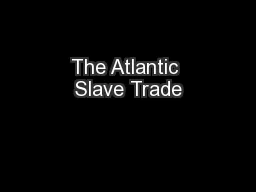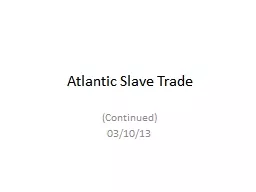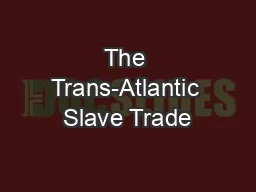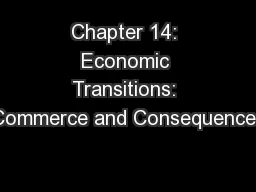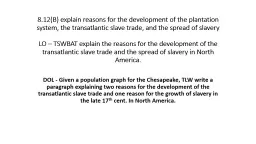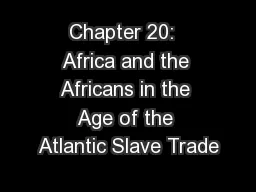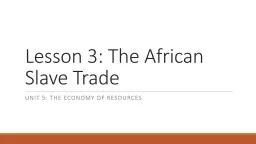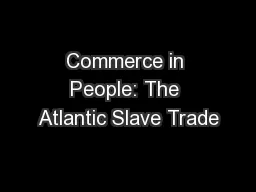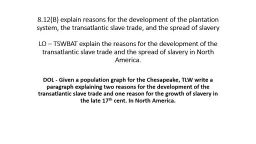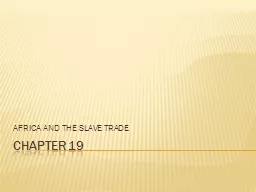PPT-The Atlantic Slave Trade
Author : phoebe-click | Published Date : 2016-05-24
15001850 The Atlantic slave trade involved the largest intercontinental migration of people in world history prior to the 20th century Ask yourself What is slavery
Presentation Embed Code
Download Presentation
Download Presentation The PPT/PDF document "The Atlantic Slave Trade" is the property of its rightful owner. Permission is granted to download and print the materials on this website for personal, non-commercial use only, and to display it on your personal computer provided you do not modify the materials and that you retain all copyright notices contained in the materials. By downloading content from our website, you accept the terms of this agreement.
The Atlantic Slave Trade: Transcript
15001850 The Atlantic slave trade involved the largest intercontinental migration of people in world history prior to the 20th century Ask yourself What is slavery Why diddoes it happen When it all started . Credit given to: Holt, Rinehart, and Winston . Publishing for portions of this presentation. Below decks on an illegal slave ship seized by a British antislavery patrol in 1846.. Reading Focus. Where did the Atlantic slave trade originate?. By . 1500. Slavery . had . mostly died . out in . Western Europe. .. Elsewhere, still common.. Participation of . all. races:. African blacks. : capturing from other tribes; internal transport; sale at major African slave markets.. . Known, collectively, as . Bulls of Donation. This bull is credited . by many historians with “ushering in the West African slave trade”. Some . historians view . the 3 bulls . together as extending the theological legacy of Pope Urban II’s Crusades to justify European colonization and expansionism. Credit given to: Holt, Rinehart, and Winston . Publishing for portions of this presentation. Reading Focus. Where did the Atlantic slave trade originate?. How did slavery evolve in the American colonies?. (Continued). 03/10/13. Islamic Slave Trade? A misnomer?. If transatlantic trade has not been called “Christian slave trade”, then it would be more appropriate to use . Arab/. P. ersian slave trade . Barbara Anderson. African Studies Center, UNC-Chapel Hill. November 2013. b_anderson@unc.edu. . . http://africa.unc.edu/. . How did the trans-Atlantic slave trade begin?. Why did Europeans choose Africans?. Margin Review Questions. What drove European involvement in the world of Asian commerce?. Desire . for tropical spices, Chinese silk, Indian cottons, rhubarb, emeralds, rubies, and . sapphires. Recovery . LO – TSWBAT explain the reasons for the development of the transatlantic slave trade and the spread of slavery in North America. . DOL - Given a population graph for the Chesapeake, TLW write a paragraph explaining two reasons for the development of the transatlantic slave trade and one reason for the growth of slavery in the late 17. Pre-Existing Slave Trade. Trans-Saharan trade routes (Red Sea and East African) had been trading slaves for centuries throughout the Middle East and Northern Africa. Mostly women: traded as concubines for harems; domestic servants. Unit 5: The Economy of Resources. What do you think? . What is . Slavery?. Slavery is when a person owns or has complete control of another person or people.. The . African Slave . Trade was . a. mass involuntary migration . AP World History Notes: Chapter 15. The Atlantic Slave Trade. Lasted from about 1500 to 1866. About 12.5 million Africans taken from their societies. About 10.7 million made it to the Americas. About 1.8 million (14.4%) died during the transatlantic crossing. Slave Trade. The idea of making someone less wealthy or less fortunate a bound servant is not new, but the degree to which the institution of slavery chained Africans was incomparable in world history. LO – TSWBAT explain the reasons for the development of the transatlantic slave trade and the spread of slavery in North America. . DOL - Given a population graph for the Chesapeake, TLW write a paragraph explaining two reasons for the development of the transatlantic slave trade and one reason for the growth of slavery in the late 17. Many kingdoms. Diff. cultures. 100 mil.. SLAVERY?. Sources? . Status? . trade. ???. Demand . Race . Slave trade. 1450-1850: 12 . mil.. Brazil. : . 42%. MAP 4.3 . Triangular Trade Across the Atlantic .
Download Document
Here is the link to download the presentation.
"The Atlantic Slave Trade"The content belongs to its owner. You may download and print it for personal use, without modification, and keep all copyright notices. By downloading, you agree to these terms.
Related Documents

